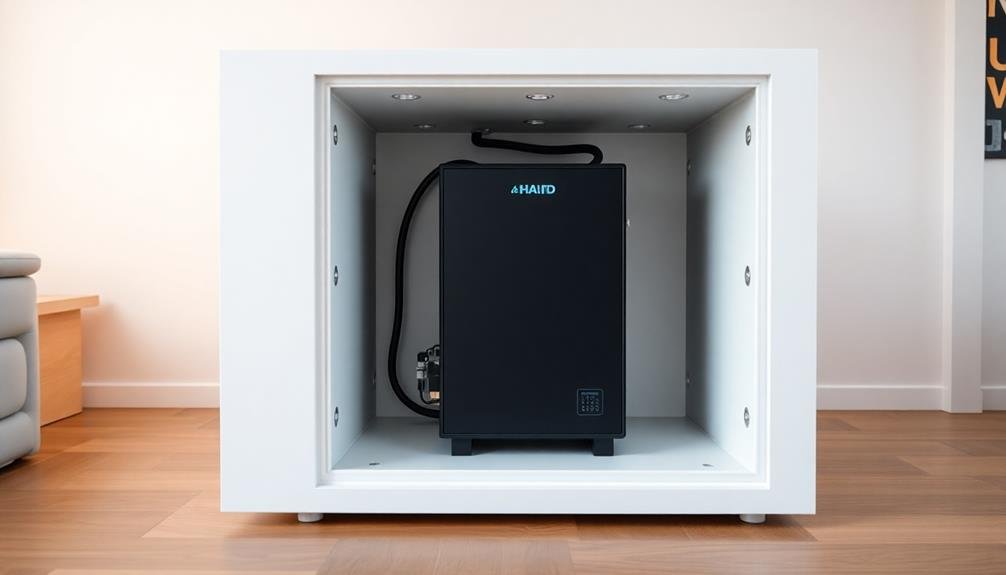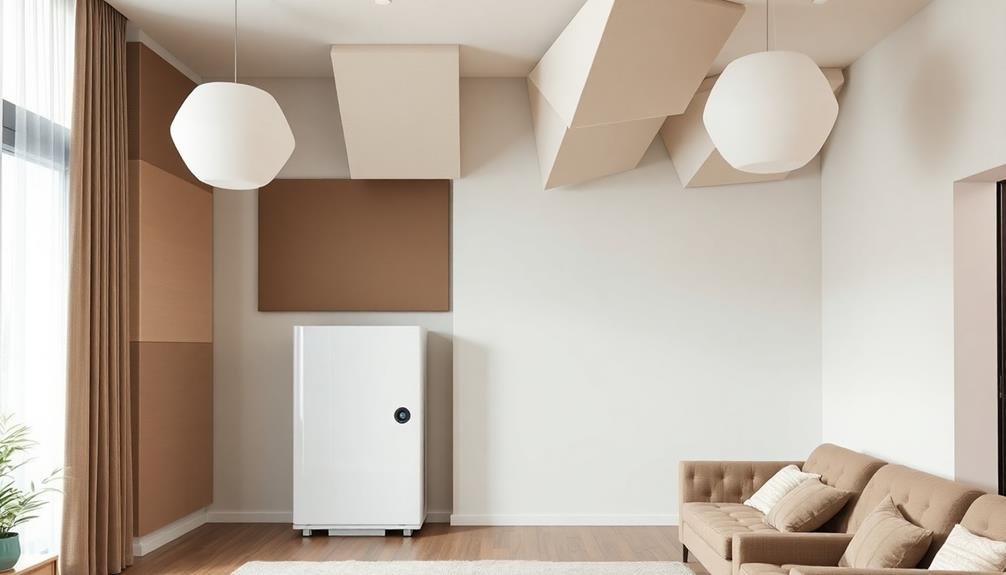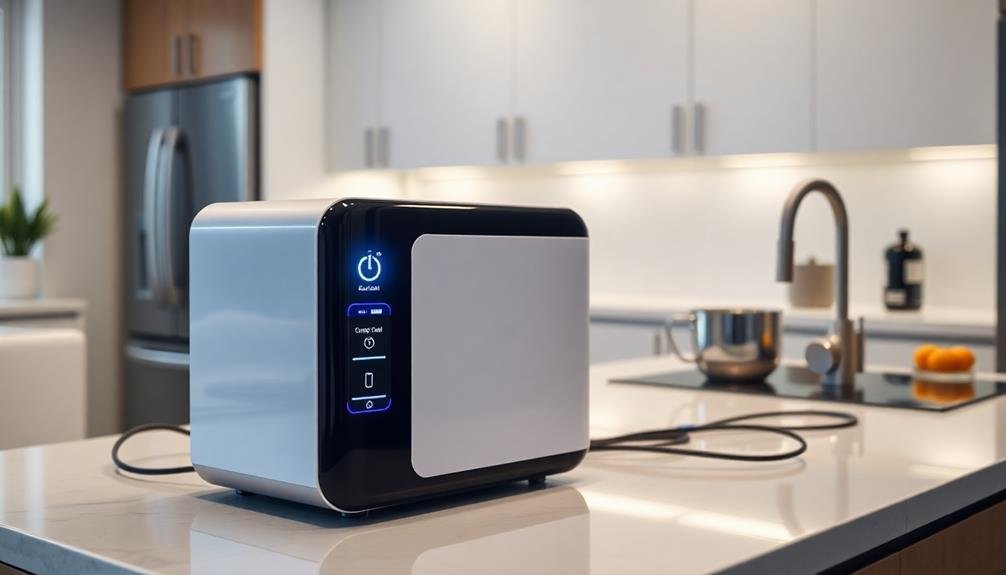To quiet your home fuel cell system, consider these three DIY solutions. First, build an insulated enclosure using sound-absorbing materials like acoustic foam or mineral wool, with a double-walled design for enhanced dampening. Second, implement vibration dampening systems by isolating the fuel cell unit with rubber mounts or vibration-absorbing pads, and use flexible connectors for pipes. Third, install acoustic panels and baffles strategically to absorb sound reflections. Choose panels with high Noise Reduction Coefficients for ideal results. You can even create DIY versions using recycled materials. These methods will greatly reduce noise, but there's more to discover about maximizing your system's silence.
Insulated Enclosures

Insulated enclosures play an essential role in creating quiet home fuel cell solutions. They're designed to minimize noise transmission from the fuel cell system to your living space.
When selecting an enclosure, you'll want to take into account materials with high sound-absorbing properties, such as acoustic foam or mineral wool.
To maximize noise reduction, opt for a double-walled enclosure with an air gap between layers. This design helps dampen vibrations and reduces sound transmission. You can further enhance the enclosure's effectiveness by adding mass-loaded vinyl or soundproofing mats to the interior walls.
Don't forget about ventilation when designing your enclosure. Fuel cells generate heat, so you'll need to incorporate adequate airflow while maintaining sound insulation. Think about using baffled vents or sound maze designs to allow air movement without compromising noise reduction.
Sealing is vital for an effective enclosure. Use weatherstripping and gaskets around doors and access panels to prevent sound leakage. Pay attention to any penetrations for pipes or wiring, sealing them thoroughly with acoustic caulk or specialized grommets.
Lastly, evaluate the enclosure's location carefully. Placing it in a basement or utility room can provide additional sound isolation from your living areas.
Vibration Dampening Systems
The hum of a fuel cell system can be a persistent annoyance without proper vibration control. To maintain a quiet environment, you'll need to implement effective vibration dampening systems.
Start by isolating the fuel cell unit from the floor using rubber mounts or vibration-absorbing pads. These materials dissipate energy and reduce the transmission of vibrations to your home's structure.
Consider installing a floating floor beneath the fuel cell, using materials like cork or specialized rubber compounds. This creates an additional barrier against vibration transfer.
For wall-mounted units, use vibration-isolating brackets to minimize noise transmission through the walls.
Don't forget about the internal components of your fuel cell system. Use flexible connectors for pipes and ducts to prevent vibration from traveling through these pathways.
Install vibration dampeners on pumps and fans to reduce their noise output.
For particularly sensitive setups, you might want to invest in active vibration control systems. These use sensors and actuators to counteract vibrations in real-time, providing superior noise reduction for your home fuel cell installation.
Remember to regularly inspect and maintain your vibration dampening systems to guarantee continued effectiveness.
Acoustic Panels and Baffles

While vibration dampening tackles noise at the source, what about sound that still manages to escape? That's where acoustic panels and baffles come in. These sound-absorbing materials can greatly reduce the noise levels in your home fuel cell installation area.
You'll want to focus on two main types: acoustic panels and baffles. Acoustic panels are flat, often rectangular units that you can mount on walls or ceilings. They're typically made of sound-absorbing materials like foam, fiberglass, or recycled materials.
Baffles, on the other hand, are suspended from the ceiling and can be more effective for larger spaces.
When choosing acoustic panels, look for those with a high Noise Reduction Coefficient (NRC). The higher the NRC, the more sound the panel absorbs. For best results, place panels strategically around your fuel cell, focusing on areas where sound tends to reflect or bounce.
DIY options are available if you're feeling crafty. You can create your own panels using materials like recycled denim, mineral wool, or even egg cartons.
Just make sure you're using fire-resistant materials and following proper safety guidelines.
Frequently Asked Questions
How Much Maintenance Do Home Fuel Cell Systems Require?
You'll find home fuel cell systems require minimal maintenance. You'll need to replace filters annually and perform occasional inspections. Most systems have self-monitoring features, alerting you to issues. Expect to schedule professional check-ups every few years for peak performance.
What's the Average Lifespan of a Residential Fuel Cell System?
You can expect your residential fuel cell system to last 10-20 years on average. With proper maintenance, you'll maximize its lifespan. However, some components may need replacement sooner. It's best to check your manufacturer's specifications for details.
Are There Any Safety Concerns With Operating Fuel Cells at Home?
You should be aware of several safety concerns when operating fuel cells at home. They include potential gas leaks, electrical hazards, and overheating. It's vital to follow manufacturer guidelines, guarantee proper ventilation, and install safety sensors.
How Do Fuel Cell Systems Compare to Solar Panels in Efficiency?
You'll find fuel cells are generally more efficient than solar panels. They can convert up to 60% of energy into electricity, while solar panels typically reach 15-20%. However, fuel cells require constant fuel input, unlike solar's free sunlight.
Can Home Fuel Cells Be Integrated With Existing Electrical Systems?
Yes, you can integrate home fuel cells with your existing electrical system. They're designed to work alongside the grid, providing supplementary power. You'll need a professional electrician to install the necessary interface equipment and guarantee proper connections.
In Summary
You've now got the tools to create a whisper-quiet fuel cell setup for your home. By combining insulated enclosures, vibration dampening systems, and acoustic panels, you'll drastically reduce noise levels. Remember, proper installation is key to maximizing these solutions' effectiveness. Don't be afraid to experiment with different combinations to find what works best for your space. With a little effort, you'll enjoy clean, efficient power without the racket. Happy DIYing!





Leave a Reply